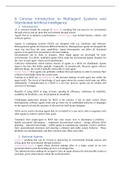A Concise Introduction to Multiagent Systems and
Distributed Artificial Intelligence
1. Introduction
AI is centered around the concept of agents (= anything that can perceive its environment
through sensors and act upon that environment through actors).
Agents that try to optimize a performance = rational agent (can include human-, robotic- and
software agents).
Agents in multiagent systems (MAS) are designed with e.g., hardware and software.
Heterogeneous agents are based on different hardware. Homogeneous agents are designed the
same way and have the same capabilities. Agent heterogeneity can affect all functional
aspects of an agent from perception to decision making.
Environments can be static or dynamic. Most single agents are developed for static
environments. In a MAS, multi(ple) agents (MA) make the environment appear dynamic for
the view of each agent, which can be problematic.
Collective information which reaches sensors of agents in a MAS are distributed. Agents
observe the data that differ spatially, temporally or semantically. Because agents observe
different things, the world is partially observable to each agent.
Sensor fusion = how agents can optimally combine their perceptions in order to increase their
collective knowledge about the current state.
Controls in a MAS are decentralized (= the decision making of each agent lies within the
agent itself). The levels of knowledge of each agent about the current world state can differ
substantially. Communication in a MAS is a two-way process, agents can be senders and
receivers of messages.
Benefits of using MAS in large systems: speedup & efficiency, robustness & reliability,
scalability & flexibility, cost, development & reusability.
Challenging application domain for MAS is the internet: it has an open system where
heterogeneous software agents come and go, there are no established protocols or languages
on the agent level and the structure of the network itself keeps changing.
MAS can be used to develop agents that act on behalf of a user and is able to negotiate with
other agents in order to achieve their goals.
Transition from single-agent to MAS may raise issues: how to decompose a problem, -
handle perceptual information, - implement decentralized control, - design efficient MAS
planning, - represent knowledge, - enable agents to communicate, negotiate, resolve conflicts,
form organizational structures and ensuring a coherent and stable system behavior. These
problems are interdependent, and their solutions may affect each other.
2. Rational Agents
Agent = anything that can be viewed as perceiving its environment through sensors and
acting upon that environment through actuators
Autonomous agent = agent whose decision making relies to a larger extent on its own
perception than to prior knowledge given to it at design time.
The optimal decision making for an agent is how an agent chooses the best possible action at
each step, given what it knows about the world around it.
, Rational agent (intelligent agent) = when the agent selects an action that optimizes an
appropriate performance measure, given what the agent knows so far. This is determined by
the user and reflects upon what the user expects from the agent in the task at hand.
Computational agent = agents which are designed to solve a particular task and are
implemented on some computing device.
The problem of decision making is that an agent is a subject of optimal control.
Observation of an agent time = θτ.
The function that would require mapping the complete history of observation is called the policy of
the agent (time t, action at).
Reflex agent = an agent that simply maps its current observation θτ to a new action at, thus
effectively ignoring the past with a reactive or memoryless policy.
Agent and environment are coupled, one cannot be defined without the other.
The existence of a world in which one of more agents are embedded in which they think, feel and
act.
State = the collective information that is contained from the world at any time in step t and is
denoted as st.
A discrete world can be characterized by a finite number of states. A continuous world can have
infinitely many states.
The world is fully observable to an agent if st = θτ.
The world is partially observable to an agent when an θτ of the agent provides only partial
information about the current state st in the form of a deterministic or stochastic observation
model.
Bayes rule:
p= probability distribution
Partially observability can be attributed to two factors: the result of noise in agent sensors and
perceptual aliasing; two stated may ‘look’ the same to an agent, although the states are different.
In an observable world the policy of a reflex agent is a mapping from world states to actions. The
state of the world at time t provides a complete characterization of the history before time t
(Markov property).
In a deterministic world, the transition model maps a state-action pair (st, at) to a single new state
st+1





